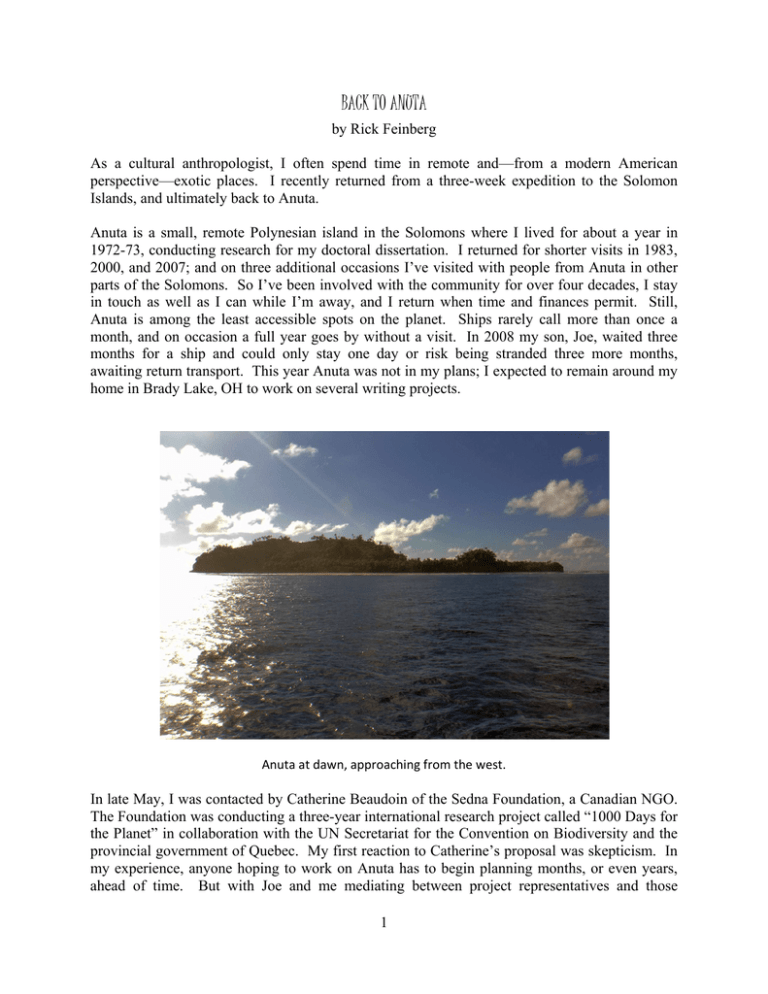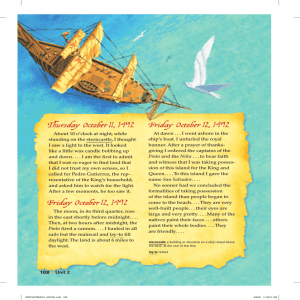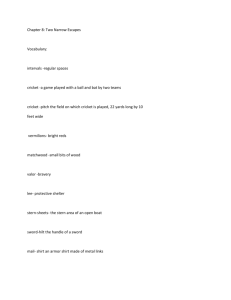BACK TO ANUTA
advertisement

BACK TO ANUTA by Rick Feinberg As a cultural anthropologist, I often spend time in remote and—from a modern American perspective—exotic places. I recently returned from a three-week expedition to the Solomon Islands, and ultimately back to Anuta. Anuta is a small, remote Polynesian island in the Solomons where I lived for about a year in 1972-73, conducting research for my doctoral dissertation. I returned for shorter visits in 1983, 2000, and 2007; and on three additional occasions I’ve visited with people from Anuta in other parts of the Solomons. So I’ve been involved with the community for over four decades, I stay in touch as well as I can while I’m away, and I return when time and finances permit. Still, Anuta is among the least accessible spots on the planet. Ships rarely call more than once a month, and on occasion a full year goes by without a visit. In 2008 my son, Joe, waited three months for a ship and could only stay one day or risk being stranded three more months, awaiting return transport. This year Anuta was not in my plans; I expected to remain around my home in Brady Lake, OH to work on several writing projects. Anuta at dawn, approaching from the west. In late May, I was contacted by Catherine Beaudoin of the Sedna Foundation, a Canadian NGO. The Foundation was conducting a three-year international research project called “1000 Days for the Planet” in collaboration with the UN Secretariat for the Convention on Biodiversity and the provincial government of Quebec. My first reaction to Catherine’s proposal was skepticism. In my experience, anyone hoping to work on Anuta has to begin planning months, or even years, ahead of time. But with Joe and me mediating between project representatives and those 1 community members who were accessible—either directly or indirectly—via email, we reached what seemed to be a mutually acceptable arrangement. Project representatives asked me to join them and facilitate arrangements on Anuta. Anutans agreed that that I should take part in the expedition, and the opportunity to see my friends on such short notice was irresistible. In contrast with my previous trips, I was traveling with an organization that has its own ship, without which a quick visit is impossible. Sedna IV is a 150foot-long three-masted schooner and is also powered by a diesel engine, which was particularly valuable when beating into the trade wind. It felt strange to have no islanders aboard and to make the trip in relative comfort. I’m accustomed to sleeping on the deck of a cargo ship, my body wedged among scores of fellow travelers, and subsisting on a diet of hard tack, tinned tuna, and occasionally a local “pudding.” Sedna IV offered comfortable cabins, a full-time cook, and Wi-Fi! The team was thoroughly international, including members from Canada, Argentina, Algeria, Belgium, and France. All are fluent in English but prefer to speak in French and currently make their homes in Quebec. I found them friendly and solicitous, but every bit as exotic as my usual traveling companions. Sedna IV. Boatswain Jerome raising sail. After four days at sea, we reached Anuta, arriving on the morning of June 29th and remaining until the evening of July 4th. During those six whirlwind days, I slept ashore, sharing a small leaf house with my “brother” (toku taina in the Anutan language), Pu Koroatu, the island’s senior chief. The rest of the team slept on the ship, coming ashore for several hours each day to interview and film. Not long after we arrived, a canoe came to the ship. I barely recognized my “nephew” (toku iraamutu), Pu Penuamuri, whom I first knew in 1972 as seven-year-old Joseph Maatua. He was the son of my then-closest friend, Pu Paone, the senior chief’s primary spokesman. Pu Paone was commonly recognized as the community’s most astute leader; he passed away around 1980, at much too young an age. Joseph was his younger son and has been trying hard to fill what we might call “his father’s shoes” except for the fact that Anutans typically go barefoot. Unlike Pu Paone, Joseph has a high school education and speaks excellent English. He and I had an 2 emotional reunion. I introduced him to team leader Jean Lemire, and they bonded right away. He guided Captain Caroline to the anchorage and continued as the team’s main guide throughout our stay. Joseph (Pu Penuamuri) in 1972 with his older brother, and in 2013. Communications had gotten garbled, and the Anutans were not expecting us until the following week. But they hurriedly organized themselves for a formal greeting ceremony. Once ashore, we were escorted to meet the two chiefs, who were seated near the beach in Mua Village. In 1972, I lived with Pu Tokerau, the senior chief’s younger brother, who was also the island’s catechist. When I returned with my family in 1983, we stayed in the chief’s house, and in 2000, I shared a small secondary house with him. That is also where I stayed on this visit. The chief has aged a great deal since I last saw him. In his early 80s, he has lost most of his teeth and uses two walking sticks to get around. He rarely leaves his house, and the farthest he travels is to church, about 200 yards away. Yet, he remains a thoughtful, forceful leader. The two chiefs and Father John Taomia (Pu Samoa) at greeting ceremony. 3 Senior chief Pu Koroatu in ceremonial regalia. I soon greeted Nau Rangitavake, Joseph’s sister. Her husband died many years ago, and her mother, Nau Paone, passed away last year. She maintains a residence a couple of houses away from the chief, who is her maternal uncle, and she looks after him, making sure he is well fed, and providing constant companionship. Nau Rangitavake. Pu Akonima. Other fond reunions were with Pu Akonima, a few years older than the chief, and Pu Rangituteki (Reuben Pakapae, son of Pu Nukumanaia, Anuta’s now-deceased master navigator). Reuben was the intellectual force behind an article that I co-authored on the island’s reef map, published in The Cartographic Journal in 2003. Pu Samoa (Father John Taomia) I knew as a child in Honiara some decades ago. Along with Joseph, he took prime responsibility for the visitors’ well-being. Ikitoru, my daughter’s namesake, is now Nau Pangatau, a married woman with three daughters and a son. She is bright and empathetic, and is adept at problem solving. Zina Kataina, is a poised, attractive young woman whom I knew as a one-year-old in Honiara in 1983. She has warm memories of the Solomons’ capital but happily contemplates living out her life on Anuta. Despite these and other reconnections with old friends, I was struck by how few of the people I knew in 1972 are still alive: only about a half dozen of my generation and up. And I was overwhelmed with all the marriages, births, deaths, and name changes since my last sustained visit, making it hard to keep track of who was who. Then, just as I was starting to put the pieces together, it was time to leave. In many ways, Anuta looks much as it did decades ago. One finds the same 212-foot hill, the same cliffs, and many of the same paths through the bush. The white-sand beach, the reefs, the surf, and passages are all virtually the same. And the gardens still produce about the same variety of crops. 4 Ikitoru (Nau Pangatau), my daughter’s namesake. Zina Kataina, grating coconut. The first change to catch my attention was the fact that many women are wearing shoulderlength hair. Even in the early 2000s, women’s hair was short, and married women shaved their heads. Fewer people now wear bark cloth every day. And the coconut-leaf shade house near the older church, where island-wide feasts and ceremonies are typically still held, has been taken down. It is no longer necessary, as natural vegetation produces plenty of shade. Expedition leader Jean Lemire sampling betel nut. Boiling coconut cream to make ritual food for welcome ceremony. I found several houses with sheets of corrugated iron covering doors or other critical areas. Perhaps half the houses are built as much as a yard above the ground. When I first visited, every building rested on the sand. And, strikingly, the kerosene lanterns that provided nearly all the lighting on my early visits have been entirely replaced by solar panels and fluorescent bulbs, 5 thanks to a provincial initiative funded by foreign donors. Solar power also means a few radios and CD players. The island has become substantially more crowded. In 1972, just over 150 people were in residence. According to island priest Pu Samoa, the resident population in 2013 stands at 227. I saw more canoes than ever waiting on the beach and out of storage. And record numbers were being sailed around outside of the reef. At one point, six or seven canoes were sailing back and forth simultaneously, almost giving the appearance of a vacation resort. They all are still equipped with outriggers and bow- and stern covers, but most are smaller than in the past. It used to be that a large canoe with three to five fishermen would return with enough fish to distribute to the entire community. That kind of haul is increasingly uncommon. I saw one canoe with a triangular sail. Decades ago, master seaman Pu Nukumanaia replaced earlier triangular pandanus-leaf sails with rectangular pieces of canvass or cotton cloth. The theory was that this would allow mariners to maximize the amount of sail and, therefore, speed without increasing the height of the mast and compromising stability. However, the advantage came at a cost: rectangular sails do not beat well into a headwind. Most canoes still use Pu Nuku’s design and sail to the fishing grounds with a tail wind, gradually working their way back with paddles. Perhaps the one triangular sail presages a new technological revolution. Most islanders agreed that food remains plentiful but disagree about trends. Nau Rangitavake proclaimed that the reef flat has become less productive because of increased access to waterproof flashlights, which encourage overfishing. By contrast, one man said canoes return with fewer fish not as a result of overfishing, but because men now concentrate on commercial shark finning rather than subsistence production. Welcome ceremony. Filming canoes under sail. People now are comfortable walking alone in the dark and say the church has purged the island of malicious spirits. At the same time, all seem to accept that chiefs wield awesome mana, a kind of spiritual power that undergirds their authority. And they are convinced that immoral behavior precipitates supernaturally-induced deprivation. The senior chief told me that people had been stealing betel nut, and that is why the trees had grown unproductive. In consequence, 6 one now must sail to Tikopia, 75 miles away, to bring back an adequate supply. Lapita Anuta, a catamaran built by James Wharram and Klaus Hympendahl as a present to the Anutans, has been well used sailing both to Tikopia and to Lata, the provincial capital, 284 nautical miles distant. Lapita Anuta in storage. Pakamatamata ceremony at top of cliff on Anuta’s north face. One revelation that surprised the project team (although it’s obvious to anthropologists) is that a visit to Anuta does not mean stepping back in time. Anutans are not living fossils or quaint museum specimens; rather they are very much a part of the twenty-first century’s globally interconnected economic and political system. Young people attend high school in several locations around the Solomons, and a few have university degrees. Engagement with the market economy has also led to suspicion and accusations of malfeasance. While on Anuta, I became involved in heated conversations about the process for approval of external groups wishing to make films or conduct research on the island and the distribution of any resources that might accrue to the community as a result of such projects. And much of my time since returning home has been devoted to explaining the new procedures and mediating conflicts. Joe has also been a key player in these negotiations and has demonstrated considerable diplomatic skill in helping bring the disparate parties together. The experience of working with a film crew was, to say the least, peculiar. Despite my decades of involvement with the community, I was, in a sense, “betwixt and between”—having to explain the crew’s objectives and strategies and secure the islanders’ cooperation. Meanwhile, the Anutans have become unusually adept at entertaining guests. They were wonderful hosts, tolerating the disruption to their lives with patience and their unique sense of humor. And overall the visitors got on extraordinarily well. The ship’s women, and several of the men, bonded quickly with the children. Lode and Jerome, professional seamen with tons of saltwater 7 Sedna IV Captain Caroline, Mike Rotu, & Scientific Communications Specialist Daphne in Solomons’ capital, Honiara. experience, shared many Anutan skills. They climbed the mountain barefoot, were enthusiastic consumers of Anutan food, and related marvelously. Local folk were curious all week about our woman captain and, to their delight, Caroline made it ashore on Thursday. In the end, everyone from the ship got to spend time on the island, and most declared the visit a high point of their lives. For additional photos and more information on the expedition (particularly for those of you who read French), check out the project website: [http://sedna.radio-canada.ca/en/home]. ___________________ Dr. Feinberg is Professor of Anthropology at Kent State University. 8







